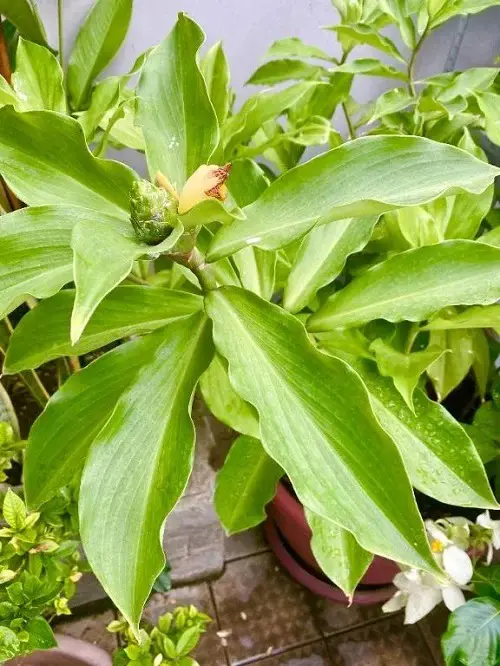Are you aware of Insulin Plant Benefits and Uses? This article showcases all the benefits it has on offer with research!

The Insulin Plant (Costus igneus), also known as ‘Spiral Ginger’ or ‘Fiery Costus,’ has garnered significant attention for its potential health benefits, particularly in managing blood sugar levels. In this article, we delve into the scientific research surrounding Insulin Plant Benefits, its active compounds, and how it can potentially support individuals with diabetes and beyond.
Insulin Plant Benefits
1. Blood Sugar Regulation
Active Compound: Polysaccharides
The Insulin Plant contains bioactive compounds, primarily polysaccharides, which may contribute to its blood sugar-regulating properties.
Research Support: Studies suggest that extracts from the Insulin Plant may help lower blood glucose levels by enhancing insulin sensitivity and increasing glucose uptake by cells.
2. Antioxidant Properties
Active Compounds: Antioxidants
The plant is rich in antioxidants, such as flavonoids and polyphenols, that combat oxidative stress and reduce free radical damage in the body.
Research Support: Antioxidants in the Insulin Plant may help protect cells and tissues from damage, potentially reducing the risk of complications associated with diabetes.
3. Anti-Inflammatory Effects
Active Compounds: Flavonoids and Phenolic Compounds
The presence of flavonoids and phenolic compounds in the Insulin Plant may contribute to its anti-inflammatory properties.
Research Support: Inflammation plays a role in diabetes and its complications. Some studies suggest that the plant’s anti-inflammatory effects may have a positive impact on diabetes management.
4. Potential Weight Management
Active Compounds: Fiber and Bioactive Compounds
The Insulin Plant is a good source of dietary fiber and bioactive compounds that may promote a feeling of fullness.
Research Support: Consumption of high-fiber foods may aid in weight management, which is important for individuals with diabetes or those at risk.
5. Heart Health Benefits
Active Compounds: Antioxidants and Flavonoids
The plant’s antioxidants and flavonoids can support cardiovascular health.
Research Support: Some studies indicate that the Insulin Plant’s compounds may help improve lipid profiles, reducing the risk of heart disease in individuals with diabetes.
6. Potential for Stress Reduction
Active Compounds: Adaptogens
The Insulin Plant exhibits adaptogenic properties, which may help the body adapt to stress.
Research Support: While more research is needed, adaptogens may assist in managing stress-related factors that impact blood sugar control.
Ways to Use the Insulin Plant

The Insulin Plant offers various methods of consumption, allowing individuals to harness its potential health benefits. Here’s a more detailed exploration of these usage options:
1. Fresh Leaves
- Chewing: One of the simplest ways to use fresh Insulin Plant leaves is to chew them directly. Chewing the leaves allows for the potential absorption of active compounds through the oral mucosa.
- Incorporating into Salads: You can finely chop fresh leaves and add them to salads, enhancing both flavor and nutrition.
- Juicing: Fresh leaves can be juiced along with other fruits and vegetables to create a refreshing and nutritious drink.
- Smoothies: Blend fresh Insulin Plant leaves with fruits and yogurt to prepare a healthy and vibrant smoothie.
2. Leaves Extract
- Preparation: To make an extract, blend fresh Insulin Plant leaves with water to create a concentrated mixture.
- Straining: After blending, strain the mixture to separate the liquid from any solid plant material.
- Consumption: The resulting liquid can be consumed directly. It’s an efficient way to ingest the plant’s potential bioactive compounds.
3. Supplements
- Available Forms: Insulin Plant supplements are available in various forms, including capsules and powders.
- Dosage: Always follow the dosage instructions provided on the supplement packaging or as advised by a healthcare professional.
- Convenience: Supplements offer a convenient way to incorporate the plant’s benefits into your daily routine.
4. Tea
- Preparation: Fresh or dried Insulin Plant leaves can be steeped in hot water to create a soothing herbal tea.
- Flavor: The tea has a pleasant, earthy flavor and can be sweetened with honey or other natural sweeteners if desired.
- Regular Consumption: Regular consumption of Insulin Plant tea may provide the plant’s potential health benefits in a warm and comforting form.
5. Culinary Applications
- Cooking: Fresh or dried Insulin Plant leaves can be used as a flavorful addition to various cooked dishes, such as curries and stir-fries.
- Seasoning: The leaves can also be used as a seasoning or garnish, adding a unique taste to your culinary creations.
Important: The efficacy and safety of these usage methods can vary from person to person. Individuals with diabetes or underlying medical conditions should consult their healthcare provider before incorporating the Insulin Plant into their regimen. Additionally, monitoring blood sugar levels and any potential side effects is advisable when using the plant for its potential blood sugar-regulating effects.
Uses and Benefits of Sweet Potato Flowers
Insulin Plant – Quick Growing Tips
Soil Requirements
- Opt for well-drained, loamy to sandy soil. Poor drainage can lead to root rot.
- Aim for a slightly acidic to neutral pH range of 6 to 7 for optimal growth.
Light and Temperature
- The plant thrives in full to partial sunlight. Ensure it gets at least 4-6 hours of direct sunlight daily.
- Maintain a temperature between 50°F to 90°F. It is sensitive to frost, so bring it indoors during winter if you live in a cold region.
Watering and Humidity
- Keep the soil moist but not waterlogged. Overwatering can lead to root decay.
- The Insulin Plant prefers moderate humidity. If growing indoors, consider placing a humidifier or a water tray near the plant.
Fertilization
- Use a balanced, slow-release fertilizer with an N-P-K ratio of 14-14-14.
- Fertilize every 6-8 weeks during the growing season and less frequently during winter.
Great Dracaena Plant Benefits (Proven In Studies)
Insulin Plant Benefits – FAQs
Q1. Can the Insulin Plant replace diabetes medication?
The Insulin Plant may complement diabetes management, but it should not replace prescribed medications. Consult your healthcare provider for personalized guidance.
Q2. Are there any side effects associated with the Insulin Plant?
While generally considered safe, some individuals may experience digestive discomfort. Consult your healthcare provider if you experience any adverse effects.
Q3. How should I incorporate fresh Insulin Plant leaves into my diet?
You can chew fresh leaves or add them to salads, smoothies, or juices. Monitor your blood sugar levels and consult your healthcare provider for guidance.
Burning Rosemary for 9 Amazing Benefits in Home & Garden
Q4. Is the Insulin Plant suitable for individuals without diabetes?
Yes, the Insulin Plant’s antioxidant and anti-inflammatory properties may offer health benefits for individuals without diabetes.
Insulin Plant Benefits – Conclusion
The Insulin Plant, with its potential blood sugar-regulating, antioxidant, anti-inflammatory, and weight management properties, offers intriguing prospects for individuals with diabetes. However, it’s crucial to emphasize that more extensive research is needed to fully understand its efficacy and safety.
As with any natural remedy, consultation with a healthcare provider is paramount before making any significant dietary or medicinal changes. The Insulin Plant holds promise as a complementary approach to diabetes management, but it should be approached with care and under proper guidance, especially when using fresh leaves or supplements.



